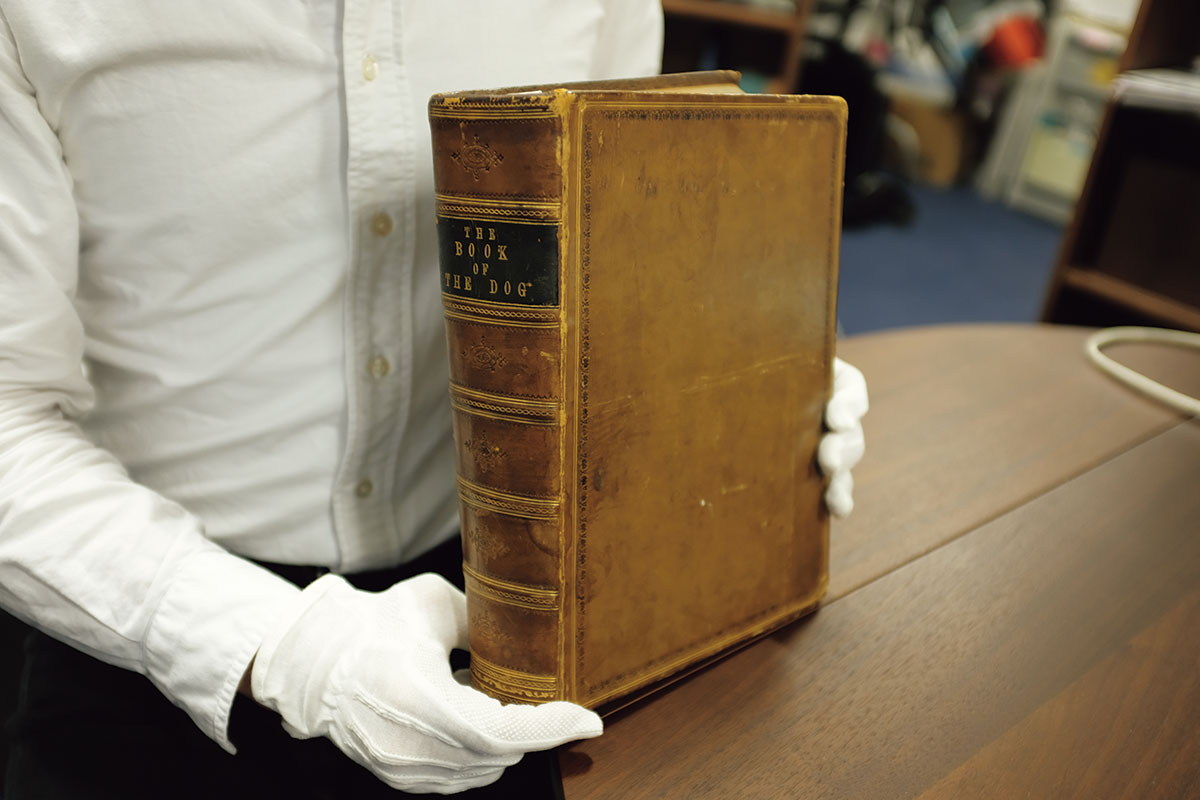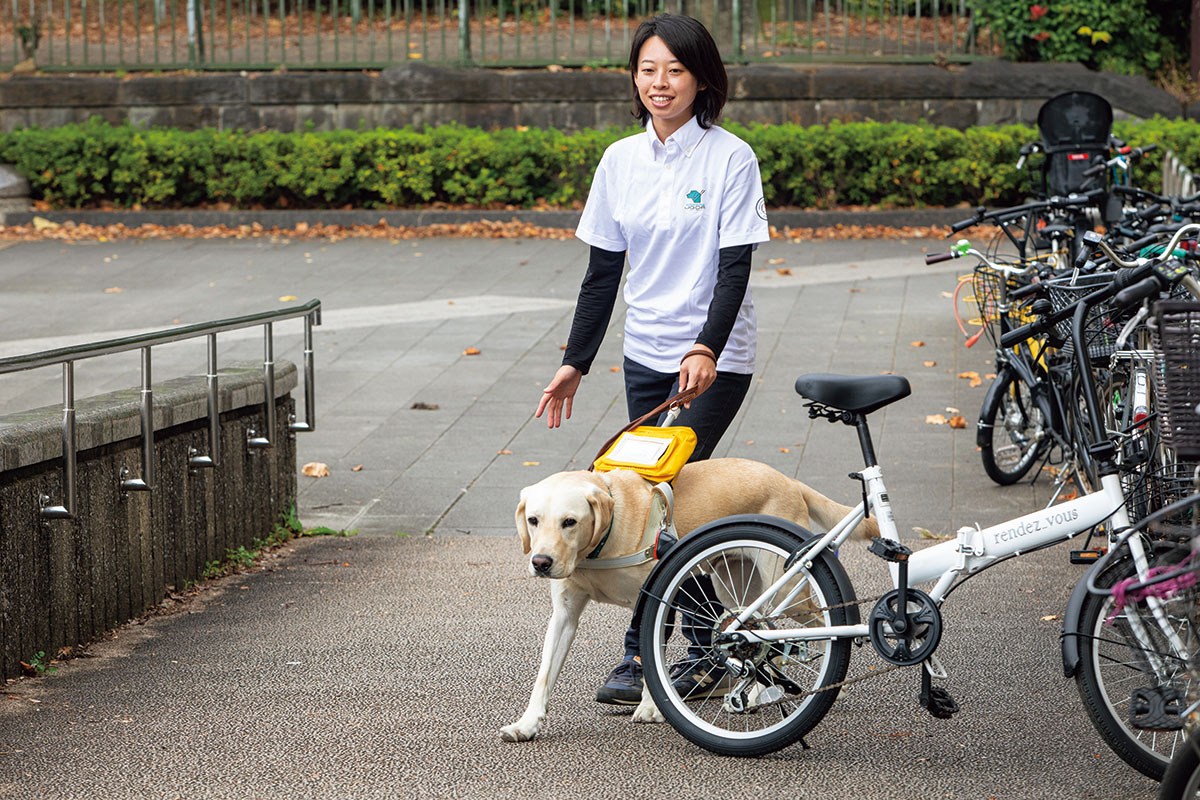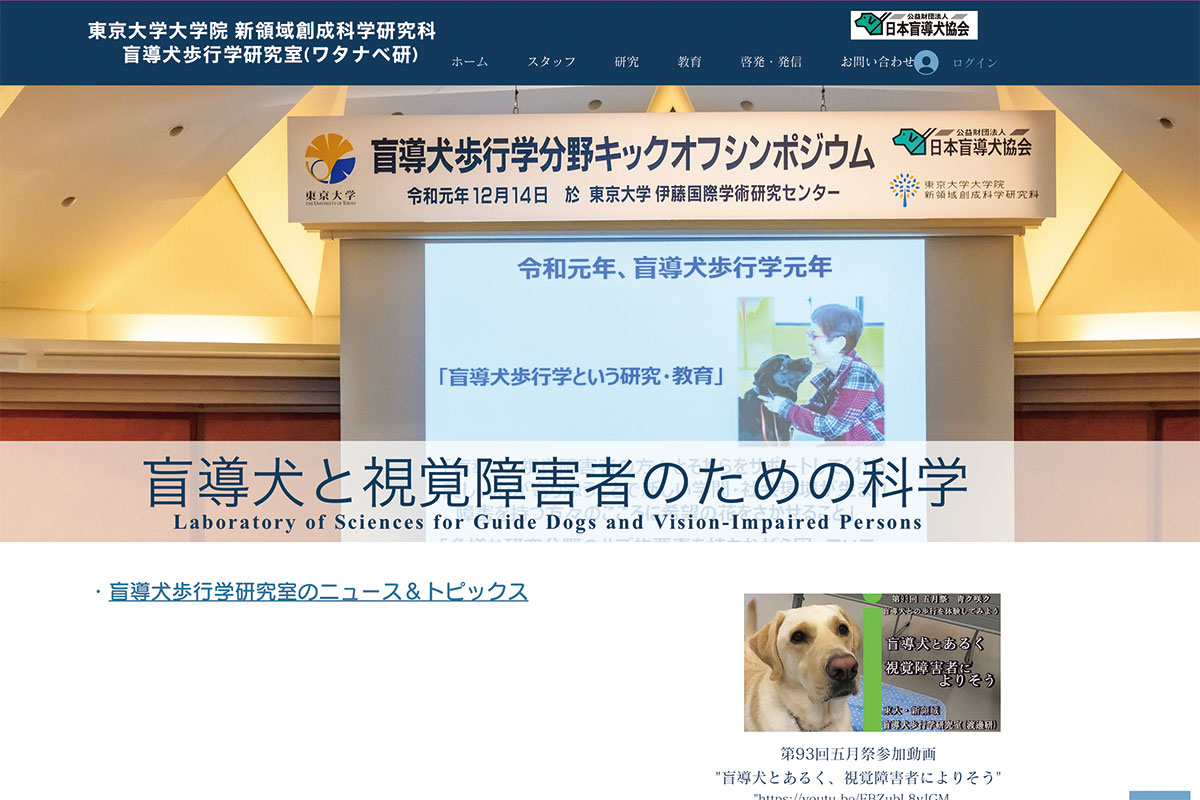Guide dogs and UTokyo

Assistance dogs serve as the eyes, ears and limbs of the people they help. The Graduate School of Frontier Sciences is conducting leading research to help meet the challenges faced by visually impaired people and guide dogs, which are a type of assistance dog. In the following, we introduce the initiatives implemented by the Graduate School, working together with the Japan Guide Dog Association, as part of the Social Cooperation Program launched to conduct studies into guide dogs. We also introduce research into guide dogs and people with visual impairments for which the Graduate School’s Laboratory of Sciences for Guide Dogs and Vision-Impaired Persons is serving as a hub. We interviewed three researchers specializing in genomics, virtual reality and information processing.
1.
Guide Dog Studies
launched at UTokyo four years ago
Manabu Watanabe
Project Professor, Graduate School of Frontier Sciences

“Project-based” research to help guide dogs and visually impaired individuals
Guide dogs help people with visual impairments to walk safely, including helping them up and down steps and around obstacles and corners. According to guide dog users, a guide dog makes it easier to get around and participate in a wider range of activities compared to meticulously tapping the ground with a white cane as they walk. There are many challenges to be met, however, including those related to the training of guide dogs and raising public awareness about visual impairments. Could the wide variety of research conducted at UTokyo contribute to solving these issues?
Hoping to make such a contribution, the Social Cooperation Program “Laboratory of Sciences for Guide Dogs and Vision-Impaired Persons” was launched in the Graduate School of Frontier Sciences in 2019. The program, which conducts joint research with the Japan Guide Dog Association, is run by Project Professor Manabu Watanabe, a veterinarian and genome researcher. The mission of his laboratory, Japan’s first for guide dog studies, is to solve issues related to both guide dogs and people with visual impairments. Through the course, the Association gathers feedback from people with visual impairments and guide dog trainers and communicates their needs to researchers at UTokyo. The results of the conducted research are then utilized in real-life settings. The Laboratory is thus contributing to the solution of social issues through a project-based, interdisciplinary approach.
Research into guide dogs and visually impaired people falls mainly into three fields: life sciences, engineering and humanities and social sciences. Project Professor Watanabe has been contacting researchers who are at the forefront in these fields to gain their support for the solution of related issues, and expects his research network to expand. “There is tremendous goodwill at UTokyo,” he explains.
“It might be difficult for a large company to make a profit from a product designed for a minority group,” he continues. “But a university can focus on minorities and provide them with support. I think this is what universities should do going forward.”


Genomic data on more than 1,000 guide dogs
One of the major issues to be solved regarding guide dogs is how few of them are available. As of March 2023, there are 836* active guide dogs in Japan, while the number of people who need them is believed to be around 3,000. There are thus not enough dogs to meet the demand. One reason for this lack of availability is that very few candidates can actually become working guide dogs. Many of the qualities required of guide dogs are genetic, but only around 30 to 40% of puppies born with the right genes make it through the training process. Moreover, labrador retrievers and golden retrievers, which are the breeds that tend to demonstrate the requisite abilities, also tend to suffer from diseases such as lymphoma, mastocytoma and angiosarcoma. These diseases cause guide dogs to become unable to continue their work before retiring from service, and can also result in early death. Users of guide dogs have been pointing to these kinds of problems as a serious issue.
In response, Project Professor Watanabe is leading the “Guide Dog Genome Project” to breed dogs that have the required qualities while being less likely to contract diseases. In this project, genomic DNA is extracted and refined from blood samples taken from candidate dogs bred by the Japan Guide Dog Association. The DNA is analyzed using the single nucleotide polymorphism (SNP) genotyping analysis method, and the dogs’ genomes are mapped. This analysis has been performed for more than 1,000 dogs, and a platform to store the blood samples and other data has also been established. Project Professor Watanabe expects that the genomic data will eventually help breeders produce a greater number of guide dogs, as it can be used to identify puppies that are better candidates and prioritize their training, thereby increasing the rate of canine candidates who actually go on to serve.
“In guide dog research up to now, there hadn’t been a project that constructed a large platform for the dogs’ genomic data,” says Project Professor Watanabe. “By establishing a system to store genomic resources appropriately, it will become possible to conduct more comprehensive research activities, including comparing the genomes of dogs that suffer from diseases and those that do not, as well as those that become guide dogs and those that don’t.”
According to Project Professor Watanabe, the project has the biggest collection of guide dog genomic data in the world. They intend to continue with the project, taking additional blood samples and accumulating more genomic information in order to increase the precision of their research. They also plan to conduct multifaceted analysis by adding data on guide dog training scores, medical data of dogs suffering from diseases and physical data about guide dogs and their users.
* Surveyed by the guide dog committee of the independence support working group of the National Council of the Agencies of the Welfare for the Blind


Making low vision more “visible” to the general public
Another mission of the Guide Dog Studies Laboratory is to raise public awareness of guide dogs and visually impaired individuals by communicating information about them. To this end, the Laboratory has conducted various events, including a symposium held at SHIBUYA QWS in July 2023. At this event, an outline of the Laboratory’s research on low vision was presented under the title, “What is low vision, normal vision and no vision?” There was also a VR experience and a dialogue on philosophy.


Lots of people associate the term “visual impairment” with a complete lack of vision. Because of this misunderstanding, people with low vision, who in Japan account for 80 to 90% of those with visual impairments, are sometimes unjustifiably criticized for using a guide dog or a white cane. In fact, visual impairments can include having a permanent black dot at the center of your field of vision, distorted or blurred vision and various other symptoms. Project Professor Watanabe says it is important that the general public become aware of this fact, and that they are provided with chances to have more contact with both guide dogs and visually impaired people. The event held at SHIBUYA QWS therefore provided its many participants with an opportunity to talk to people with visual impairments and to interact with a guide dog.
“Talking with people with visual impairments gives you new insights that you could not gain otherwise,” says the professor. “By gaining new insights, you can start something new. I want to hold more events like this one that provide participants with opportunities to become familiar with diversity and talk with people who might be different from them, leading to the creation of a mutually supportive society.”



-
Website of the Guide Dog Studies Laboratory (Watanabe Lab), where you can see a video of the event (Japanese language only):
Read part 2 here:
Guide dogs and UTokyo (part 2)






